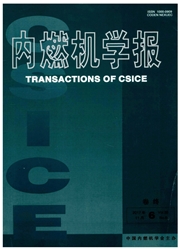

 中文摘要:
中文摘要:
为了提高采用大型详细反应动力学机理的燃烧反应流计算的效率,基于路径通量分析机理简化法建立了一种新型的动态自适应反应动力学机理简化计算方法。通过对癸烷/空气混合物的均质着火过程和球形火焰传播过程的计算,并与详细机理计算结果进行对比分析,证明了该方法能够精确地模拟组分、温度和火焰半径的变化过程。该方法的使用使得在均质着火和火焰传播的模拟中,参与计算的组分和反应数目大大减少。计算中还得到了组分在燃烧过程中的分布概率曲线,从中分析出该方法加速计算的原因。该方法可以应用于反应流的直接数值模拟和大涡模拟之中,以提高整体计算的效率。
 英文摘要:
英文摘要:
A dynamic adaptive chemistry(DAC)is developed based on the path flux analysis(PFA)model reduction approach to increase drastically the computation efficiency of combustion modeling with large,detailed kinetic mechanism.This new method is applied to the simulation of homogeneous ignition and unsteady flame propagation of n-decane/air mixtures.The comparison between results predicted by dynamic adaptive chemistry and those by detailed chemistry shows that this method can accurately reproduce the species time histories and ignition delay times.Compared to the detailed mechanism,there are much smaller numbers of active species and reactions with DAC method.The effects of the mechanism size and criteria of model reduction in path flux analysis are investigated.Results show that the computation efficiency of DAC increases with the size of chemical kinetic mechanisms.This scheme can be used for direct numerical simulations and large eddy simulations with detailed chemical mechanisms to improve the computation efficiency.
 同期刊论文项目
同期刊论文项目
 同项目期刊论文
同项目期刊论文
 On the extraction of laminar flame speed and Markstein length from outwardly propagating spherical f
On the extraction of laminar flame speed and Markstein length from outwardly propagating spherical f Effects of radiation and compression on propagating spherical flames of methane/air mixtures near th
Effects of radiation and compression on propagating spherical flames of methane/air mixtures near th A dynamic adaptive chemistry scheme with error control for combustion modeling with a large detailed
A dynamic adaptive chemistry scheme with error control for combustion modeling with a large detailed 期刊信息
期刊信息
